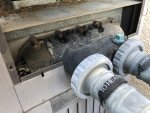- Mar 5, 2017
- 603
- Pool Size
- 17000
- Surface
- Plaster
- Chlorine
- Salt Water Generator
- SWG Type
- Hayward Aqua Rite (T-9)
My Hayward H300 is interrupting my plans for a nice Sunday soak.
the pump was on high, pressure is fine (18 psi) at 2900 rpm. Water is dribbling out at a good pace from the header. In the image, you can see top bolts showing rust and the water seems to be coming out of the top area there; the area shows the dust/sand is cleaned off from the recent running water. The pump is off when I took the picture maybe 10 min after shutting it off.
Is this a gasket issue or a exchanger issue?
When the heater is off, in ”pool” mode, it doesn’t appear to leak, but it’s too soon to be sure, the waters coming out of the header gasket seating area.
UPDATE: I’ve been running the pump for 10 minutes and now it’s not leaking. ??!
?

the pump was on high, pressure is fine (18 psi) at 2900 rpm. Water is dribbling out at a good pace from the header. In the image, you can see top bolts showing rust and the water seems to be coming out of the top area there; the area shows the dust/sand is cleaned off from the recent running water. The pump is off when I took the picture maybe 10 min after shutting it off.
Is this a gasket issue or a exchanger issue?
When the heater is off, in ”pool” mode, it doesn’t appear to leak, but it’s too soon to be sure, the waters coming out of the header gasket seating area.
UPDATE: I’ve been running the pump for 10 minutes and now it’s not leaking. ??!
?

Last edited:

